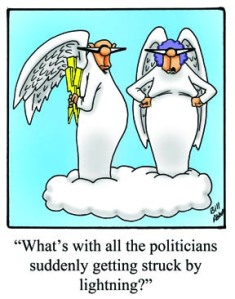In the world of cartooning, few things are perceived as ‘ultimate success’ more than syndication. Cartoon characters such as Garfield and Snoopy have woven their way into the national fabric, and made their creators wealthy beyond their wildest imaginations. Calvin and Hobbes have enjoyed an unparalleled level of success, and Calvin can still be seen desecrating the name of various auto manufacturers on the rear windows of a hefty number of pick-up trucks winding through the roads of America, much to the chagrin of their creator.
So, what is syndication and how does it work? First, I must state that I am not syndicated with one of the major syndicates. My work is distributed nationally in the Funnies Extra through Ink Bottle Syndicate, led by Bill Kellogg who has made the comic Tundra one of the more successful dailies in the marketplace – over 500 newspapers. But I, like most cartoonists in the early stages of their careers, read everything I could on the subject (see resources below), and have a reasonable handle on the process and potential outcomes.
A syndicate acts as a powerful sales force on behalf of a cartoonist. They represent and distribute cartoons to newspapers nationwide and, in some cases, internationally, for which they receive approximately half of the revenue generated by the comic. That figure varies depending on the success of the feature, and the negotiating skills of the attorneys involved.
Gaining the interest of a syndicate is, in itself, an enormous achievement. King Features Syndicate, for one, receives thousands of submissions every month from cartoonists, covering a wide spectrum of talent levels. Much of the wave of submissions they open are of a high, professional quality, yet they still end up in the rejection pile. Not only does your cartoon need to be of the highest standard, it has to be consistent in quality, it has to have sufficiently developed characters that will be engaging to a diminishing reading public over time, and it has to be unique in a world awash with cute puppies, talking cats, and unique, kooky families.
If you find yourself with an indication of interest from a major syndicate, you still must be prepared for significant challenges. As you likely already know, the newspaper markets are continuing to shrink, and those that remain have desperately tight budgets. Supposing you are offered a development deal, the income you can expect will be insufficient to pursue cartooning full time. Even after a successful launch, and a well established feature, many syndicated cartoonists now have other full time careers in order to pay their living expenses. There are still a few comic leviathans making a handsome income from their cartoons, but many of them are ‘legacy strips’ – those that were started long ago by a now deceased cartoonist, and continued by a family member, or an artist appointed by the syndicate.
Depressed yet? Don’t be. Yours may be the feature that connects with a public starving for something new and fresh, and a big syndicate may put it’s massive marketing power behind you and your cartoon. But what if it doesn’t? Is it the end of the road for your work? Hardly. As mentioned earlier, I’m represented by a small syndicate run by Bill Kellogg. Bill single-handedly approached newspaper editors around the country and succeeded in getting the very funny “Tundra” comic into 500 newspapers. If I’m not mistaken (and I very well could be), the average income per 100 newspapers was around $40,000 per year, give or take. That number has likely decreased since I’d heard that figure, but if it’s still reasonably correct, that’s $200,000 from the newspapers alone. Certainly a livable income (depending, of course, on your tastes!)
Self-syndication is the process of acting as your own sales force, marketing agency, and, of course, creator – in effect, your own syndicate. While this is a challenging and time-consuming route, there are also significant benefits. First, you keep all the money rather than split it with someone else. That means that you’ll need fewer newspapers to sign your feature in order to make a livable income. Second, you can be assured your strip is getting the backing it deserves. If a syndicate’s sales force doesn’t get behind your strip, regardless of its potential, it’ll end up a flop and the syndicate will terminate your contract. With you driving sales, you’ll have your fingers on the pulse of the market-place, and you will determine the ultimate outcome. Have a look at the List of Newspapers – there’s links to 25,000 different papers broken down by country. By contacting their features editors or managing editors, you may find yourself with a very viable cartoon property.
While the traditional syndication route has lost much of its financial potential and momentum in conventional print markets, it’s hardly the end of the road. A new dynamic is emerging, and cartoonists with ambition, drive, and a good product stand to do very well. As with all things, having perseverance, a clear goal, and a vision for the future, are the ingredients for a successful and fulfilling career in cartooning.
For more information, I’d recommend (among others), the following resources:
Successful Syndication: A Guide for Writers and Cartoonists
How to Be a Successful Cartoonist
How to Self Syndicate a Comic Strip
Selling Cartoons To Newspapers




Thank you Bill, for yet another insightful post for aspiring cartoonists!
Excellent post, Bill. My partner Jaime and I are thinking about self-syndication for our strip, Kate the Great, and you’ve definitely provided us with some excellent resources for getting started.
It’s exciting to find an article from someone who works with Mr. Kellogg. His achievements are legendary, and Jaime and I would love to get on his grid.
Thanks again for the awesome information!
Thank you Wayne – you’ve got a really good strip there and imagine you’ll do we’ll with traditional or self-syndication. Keep us posted!